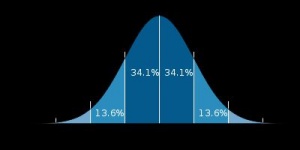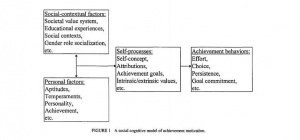Difference between revisions of "Gifted"
(→Giftedness and Motivation as Seperate Factors) |
(→Measuring Intellectual Giftedness) |
||
| Line 16: | Line 16: | ||
(74th legislature of the State of Texas, Chapter 29, Subchapter D, Section 29.121) [http://books.google.com/books?id=9vHK8DCjhLoC Identifying Gifted Students] | (74th legislature of the State of Texas, Chapter 29, Subchapter D, Section 29.121) [http://books.google.com/books?id=9vHK8DCjhLoC Identifying Gifted Students] | ||
| − | + | [[Image:Normal Distribution.jpg|thumb|Normal Distribution]] | |
Yet even if the US public school identifies various factors as playing a part in giftedness, the IQ test is still considered to be the central tool in diagnosing giftedness. This is due to its consistency and high level of development, which allows for a particular student's scores to be measures against a very large sample's score. | Yet even if the US public school identifies various factors as playing a part in giftedness, the IQ test is still considered to be the central tool in diagnosing giftedness. This is due to its consistency and high level of development, which allows for a particular student's scores to be measures against a very large sample's score. | ||
Revision as of 08:33, 26 March 2009
This page is reserved for work on the topic of intellectual giftedness and motivation.
Giftedness or Intellectual Giftedness is characterized by intellectual development in children that surpasses those of their same age. Gifted children often show greater ability at grasping harder academic concepts and at times greater creativity than those of their same grade level.
Contents
Measuring Intellectual Giftedness
Though all measures of giftedness attempt to classify students with intellectual ability higher than their peers, it continues to be heavily debated. In the United States public school system the classification of gifted individuals is reffered to as:
a child or youth who performs at or shows the potential for performing at a remarkably high level of accomplishment when compared to others of the same age, experience or environment and who:
1) exhibits high performance capability in an intellectual, creative, or artistic area
2) possesses and unusual capacity for leadership or
3) excels in a specific academic field
(74th legislature of the State of Texas, Chapter 29, Subchapter D, Section 29.121) Identifying Gifted Students
Yet even if the US public school identifies various factors as playing a part in giftedness, the IQ test is still considered to be the central tool in diagnosing giftedness. This is due to its consistency and high level of development, which allows for a particular student's scores to be measures against a very large sample's score.
Within studies that use IQ tests, the The common cutoff for giftedness is one standard deviation above the mean, or 84th percentile and above.
Giftedness and Motivation
The split in the role of motivation and giftedness is between those that theorize giftedness as being a mixture of talent and motivation and those that theorize giftedness as innate talent.
Giftedness and Motivation as Seperate Factors
Considered to be the traditional view on giftedness, it sees giftedness as an innate ability within the individual. This ability is considered as necessary if the child develops later giftedness or talent, and thus becomes the starting point for the child's later abilities. Though motivation is a part of this model, it is seen as playing somewhat of a moderating role rather than an central role in the development of later abilities or talents.
The model for this theory is called the Differentiated Model of Giftedness and Talent, propoosed by Francoys Gagne. Six mediating factors are said to affect how a child's inherent giftedness develops into later talent, 1) the natural ability or gift 2) chance 3) intrapersonal catalyst 4) environmental catalyst 5) learning/practice and 6) talent.
These mediating factors bring strength to the theory in that they account for gifted students having differing strengths in different fields. Also, the emphasis in this model is placed on the academic career of the child as being a large determinant in later talent.


